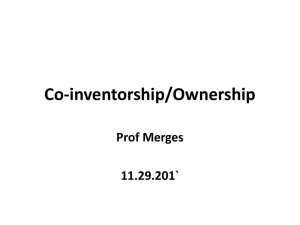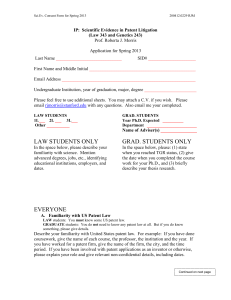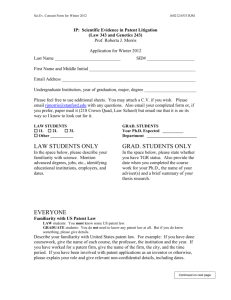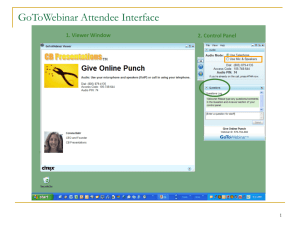Co-inventorship/Ownership
advertisement
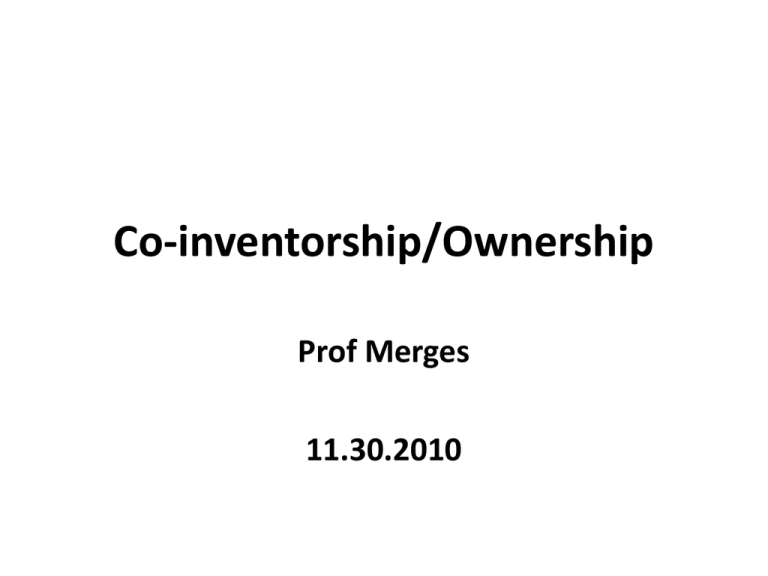
Co-inventorship/Ownership Prof Merges 11.30.2010 News Flash! • Microsoft Corp. v. i4i Ltd. (Supreme Court 2010) • The Supreme Court has granted Microsoft's petition for a writ of certiorari and will consider whether patent law requires clear and convincing evidence of invalidity in order to invalidate an issued patent. Co-inventorship/Ownership • In the first instance, the inventor is the owner • Co-inventors are therefore, in the absence of any agreement, co-owners • Co-owners have complete right to use full invention with no liability to other co-owners 35 U.S.C. 262 “[I]n the absence of any agreement to the contrary, each owner may make, use, offer to sell, or sell the patented invention within the Unites States, or import the patented invention into the United States without the consent of and without accounting to the other owners.” Rights of Co-owners • Each co-owner owns an undivided interest in the entire patent – Not subdivided by claims – Not related to “percentage contribution” of each inventor – Ethicon situation, p. 1272 Cases and principles • Burroughs-Wellcome • Stark • Stanford v Roche Burroughs-Wellcome • Standard for co-invention Janet Rideout – AZT Inventor Samuel Broder - NIH Burroughs standard • 271(e) case; screening program • Note timing: why important? – Feb, 1985 events • NB: “license defense”, p. 1143 Burroughs-Wellcome • “Coinventorship as a defense to infringement” – License from (putative?) coinventor who has not otherwise assigned his/her interest can provide defense to infringement defendant – Crucial: standard for determining coinventorship 35 U.S.C. 116 Inventors When an invention is made by two or more persons jointly, they shall apply for patent jointly and each make the required oath, except as otherwise provided in this title. Inventors may apply for a patent jointly even though (1) they did not physically work together or at the same time, (2) each did not make the same type or amount of contribution, or (3) each did not make a contribution to the subject matter of every claim of the patent. Role of conception • Conception = invention; joint conceiver is a joint inventor “The test for conception is whether the inventor had an idea that was definite and permanent enough that one skilled in the art could understand the invention; the inventor must prove his conception by corroborating evidence.” – p. 1144 Stark v. Advanced Magnetics • Interlocutory appeal • Issue: Standard for correction of inventorship § 256. Correction of named inventor Whenever through error a person is named in an issued patent as the inventor, or through error an inventor is not named in an issued patent and such error arose without any deceptive intention on his part, the Director may, on application of all the parties and assignees, with proof of the facts and such other requirements as may be imposed, issue a certificate correcting such error. The error of omitting inventors or naming persons who are not inventors shall not invalidate the patent in which such error occurred if it can be corrected as provided in this section. The court before which such matter is called in question may order correction of the patent on notice and hearing of all parties concerned and the Director shall issue a certificate accordingly. § 256. Correction of named inventor The error of omitting inventors or naming persons who are not inventors shall not invalidate the patent in which such error occurred if it can be corrected as provided in this section. The court before which such matter is called in question may order correction of the patent on notice and hearing of all parties concerned and the Director shall issue a certificate accordingly. Stark • Court earlier rejected estoppel theory put forth by AMI • Put squarely question of interpreting section 256 Stark • Misjoinder: wrongly added inventor • Nonjoinder: wrongly omitted inventor § 256. Correction of named inventor Whenever through error a person is named in an issued patent as the inventor, or through error an inventor is not named in an issued patent [, -- ?] and such error arose without any deceptive intention on his part, the Director may, on application of all the parties and assignees, with proof of the facts and such other requirements as may be imposed, issue a certificate correcting such error. Administrative remedy: section 116 Whenever through error a person is named in an application for patent as the inventor, or through error an inventor is not named in an application , and such error arose without any deceptive intention on his part, the Director may permit the application to be amended accordingly, under such terms as he prescribes. Claim 15 “Not insubstantial contribution” by Party D US Patent # 000 Claim 15 Party D’s contribution to the patent US Patent # 000 Inventors: A,B, and C Claim 15 Tenancy in common Patent 000 Inventor D’s contribution Bootstrapping a complete defense • One “not insubstantial contribution” to one claim leads to complete co-ownership interest in entire patent • How to fix or prevent? Research before filing; reissue; 256 action; other? Stanford v. Roche • Inventorship ownership co-owner defense no standing (not all owners joined) • Additional issue: Bayh-Dole Act and federally-funded research Mark Holodniy - Stanford The claimed technology • Use of PCR amplification to detect HIV levels in blood samples • Cetus – owned basic PCR patents (through employee Kerry Mullis) Researchers wearing 2 hats Roche defense • Holodniy assigned invention rights to Roche, via Visitors Confidentiality Agreement (VCA) • Roche is therefore a co-owner of the Stanford patents, through Holodniy VCA - assignment In February 1989, Holodniy began regular visits to Cetus over several months to learn PCR and to develop a PCR-based assay for HIV. Holodniy signed a “Visitor's Confidentiality Agreement” (“VCA”) with Cetus. The VCA stated that Holodniy “will assign and do[es] hereby assign to CETUS, my right, title, and interest in each of the ideas, inventions and improvements” that Holodniy may devise “as a consequence of” his work at Cetus. On April 6, 1995, Stanford formally notified the Government that it elected to retain title to the inventions under the BayhDole Act, 35 U.S.C. §§ 200-212. J.A. 5095. All three patents-in-suit contain the notation: “This invention was made with Government support under contracts AI27762-04 and AI27766-07 awarded by the National Institutes of Health. The Government has certain rights in this invention.” Roche defense Roche pleaded its ownership theory in three forms: as a declaratory judgment counterclaim, an affirmative defense, and a challenge to Stanford's standing to sue for infringement. Disposition While we agree with the district court that the statutes of limitation preclude Roche from obtaining a judgment of ownership, we do not agree that such determination prevents Roche from asserting Stanford's lack of ownership of Holodniy's interest as a defense and a challenge to Stanford's standing to maintain its action against Roche. – 583 F3d at 839 “Although state law governs the interpretation of contracts generally, the question of whether a patent assignment clause creates an automatic assignment or merely an obligation to assign is intimately bound up with the question of standing in patent cases. We have accordingly treated it as a matter of federal law.” DDB Techs., L.L.C. v. MLB Advanced Media, L.P., 517 F.3d 1284, 1290 (Fed.Cir.2008). Stanford assignment [U]pon joining Stanford, Holodniy executed the CPA with Stanford on June 28, 1988. Holodniy signed as a “Fellow” in the Department of Infectious Disease. In the CPA, Holodniy acknowledges that Stanford enters into “Contracts or Grants” with…the Government, and that he may “conceive or first actually reduce to practice” various inventions. Paragraph 2 of the CPA then recites: “I agree to assign or confirm in writing to Stanford and/or Sponsors that right, title and interest in ... such inventions as required by Contracts or Grants.” We have held that the contract language “agree to assign” reflects a mere promise to assign rights in the future, not an immediate transfer of expectant interests. IpVenture, Inc. v. Prostar Computer, Inc., 503 F.3d 1324, 1327 (Fed.Cir.2007) (interpreting “agree to assign” as “an agreement to assign,” requiring a subsequent written instrument) – 583 F.3d at 842 Effect of “agreement to assign” While Stanford might have gained certain equitable rights against Holodniy, see Arachnid, 939 F.2d at 1581 (“equitable rights.”), Stanford did not immediately gain title to Holodniy’s inventions as a result of the CPA, nor at the time the inventions were created. Paragraph 3 of the VCA recites: “I will assign and do hereby assign to CETUS, my right, title, and interest in each of the ideas, inventions and improvements.” In contrast to the CPA, the VCA's language of “do hereby assign” effected a present assignment of Holodniy's future inventions to Cetus. E.g., Speedplay, Inc. v. Bebop, Inc., 211 F.3d 1245, 1253 (Fed.Cir.2000) … Therefore, Cetus immediately gained equitable title to Holodniy's inventions. Therefore, Cetus's equitable title converted to legal title no later than the parent application's filing date. Holodniy executed an assignment of his rights in the parent application to Stanford on May 4, 1995. However, because Cetus's legal title vested first, Holodniy no longer retained his rights, negating his subsequent assignment to Stanford during patent prosecution. Bona fide purchaser (BFP) issue 35 U.S.C § 261 (2006): “An assignment, grant or conveyance shall be void as against any subsequent purchaser or mortgagee for a valuable consideration, without notice, unless it is recorded in the Patent and Trademark Office within three months from its date or prior to the date of such subsequent purchase or mortgage.” “Generally, a bona fide purchaser is one who purchases legal title to property in good faith for valuable consideration, without notice of any other claim of interest in the property.” Good faith: no notice of prior, superior claim of title Absent here: Stanford on “inquiry notice” re: Cetus assignment Bayh-Dole Issue • The Act allows the Government to take title to “subject inventions” under certain circumstances, id. §§ 202(a), 202(b), or the “contractor” universities or inventors to retain ownership if the Government does not, id. § 202(d). [T]he Act did not automatically void Holodniy's assignment to Cetus, and provided the Government with, at most, a discretionary option to his rights. The district court noted, however, that under 35 U.S.C. § 202(d), Holodniy, as an inventor, could keep title to his inventions only “[i]f a contractor does not elect to retain title to a subject invention.” On appeal, Stanford insists that Holodniy's rights were “contingent” upon his CPA obligations to assign them to Stanford, and that Stanford's election of title in 1995 gave it all patent rights. Stanford identifies no authorities or reasons why its election of title under Bayh-Dole had the power to void any prior, otherwise valid assignments of patent rights. However, Holodniy transferred his rights to Cetus more than six years before Stanford formally notified the Government of its election of title. Stanford argument • “Retains title” – will make much of this • Future vs present assignment – enough to divest “contractor” of title, and government of its rights, under Bayh-Dole?
